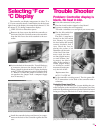
10 Single-Speed/Ramp-Hold
Display
Messages
(Page 9) Ready for you to enter an alarm
temperature. When the kiln reaches that tempera
-
ture, the alarm will sound. ( also flashes
when the alarm sounds.)
(page 9) Ready for you to edit the target
temperature of the current Ramp-Hold segment
during firing. Example: You are fusing glass to a
temperature of 1450°F. At 1445°F, you look at the
glass through a peephole and realize that the glass
will need at least another 50° to fuse fully. Change
the target temperature to 1500° without having to
turn off the kiln to reprogram it.
Fired to completion.
(page 4) Delay is a count-down timer that
starts the firing when the time runs out.
or (and temperature) (pages 6, 8)
The controller is ready for you to enter the target
temperature (the temperature that the kiln will fire
to). Each segment in Ramp-Hold mode has a target
temperature.
Full power firing rate. At this setting the kiln
will fire at its fastest rate. There are two ways to se-
lect full power:
1) Select in Single-Speed mode.
2) Select a rate of 1799°F/999°C at the prompt
in Ramp-Hold mode. A fast way to do this is to press
the key once from . will ap
-
pear.
(pages 6, 8) Hold time of a segment,
shown in hours and minutes. (Example: 2 hours
and 15 minutes = 02.15)
(Page 8) Add Hold Time: During a firing, you
can extend the hold time of a segment without hav
-
ing to firststop the firing toreprogram the controller.
(page 3) The controller is ready for you to en
-
ter a program or to begin a repeat firing.
Firing has begun. A moment after ap
-
pears, you will hear the relay(s) clicking.
Segment 3 lowers temperature to 800°F/426°C, the typi
-
cal casting temperature for silver. (Most types of gold cast
at 900°F / 482°C.)
Note: Casting temperature depends on the size of the
mold. The temperatures above are only a guide. See
your jewelry supply dealer for temperature
recommendations.
Burnout Instructions
Place ametal trayinside the kilnon three ½”posts.
Place the moldon a wire mesh screenon top of the
tray. The mold’s sprue hole should be down. The
tray will catch melting wax as it drips from the
sprue hole.
Keep the kiln’s vent hole(s), if any, open during
wax elimination. If the kiln has no vent hole, leave
the door open ½”. This allows fumes to escape the
kiln. Heat the kiln to 300°F / 148°C and hold it at
that temperature for at least one hour.
CAUTION: Do NOT heat the wax above 300°F /
148°C. Hold at 300°F / 148°C for at least one hour.
During this hour, the wax will melt from the mold and
drip into the tray. If the kiln gets hotter than 300°F /
148°C, the wax may smoke and deposit carbon inside
your kiln, causing expensive damage.
After one hour at 300°F /148°C, open the kiln. Re-
movethe moldandwax tray.Pourthe waxfrom the
tray and leave the tray out of the kiln until your
next wax elimination. (Do not leave the tray in the
kiln!)
Heat the mold to the temperature recommended
by your jewelers’ supply house where you pur
-
chased the mold material. This is usually around
1350°F / 732°C.
Lower the temperature to the casting temperature
of the metal. Hold at that temperature until you
are ready to begin casting. Remove the mold with
tongs. Wear protective gloves and safety glasses.
Saving a Carbon-Damaged Kiln
If you follow the above directions, your kiln should be
safe from wax damage. In some cases, a small amount of
carbon may form on the walls over a period of time. This is
due to the burning of wax residue that was left in the mold.
Forthis reasonwe recommendthat youperiodicallyfire the
kiln to 1500°F / 815°C as follows:
Open the vent cover(s) or leave the door ajar ½”.
Fire the kiln empty to 1500°F / 815°C at a rate of
300°F / 166°C with a one hour hold (01.00).


















